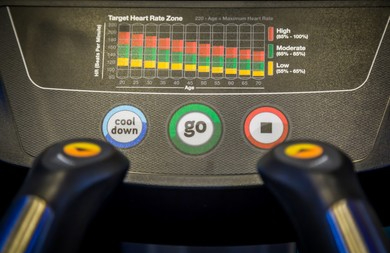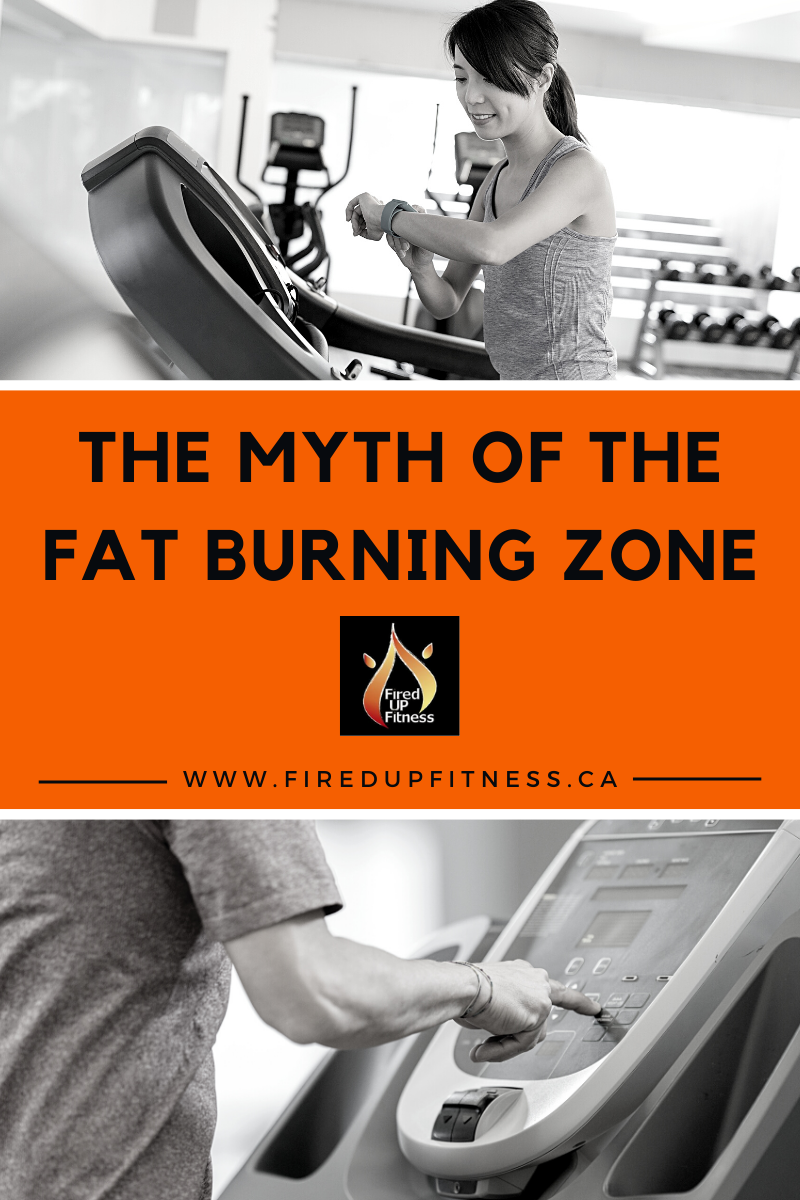If you’ve ever been on a piece of cardio equipment at home or the gym, you will likely have noticed a little chart or graph that lists heart rate zones.
The graph will have heart rates (in beats per min) up the left side with age across the bottom. There will be colourful zones identified in the center: a lower zone, a moderate or fat burning zone, an aerobic or cardio zone and potentially an anaerobic or high intensity zone.

The intention is that you decide what zone you want to work in and make sure your heart rate is in that range associated with your age. In addition to this many machines have pre-programmed workouts like intervals, hills, cardio or fat burning.
So you want to burn fat….and many of us do…you should workout in the fat burning zone right?
Well, not so fast. There is so much more to the story! “Fat burning” and “Cardio” modes on the control panels of exercise equipment are so misleading. They are based on the premise that if you exercise at a particular intensity, your body will preferentially use fat as fuel over carbohydrates therefore allowing you to burn more fat in your workout.
The Facts of the Fat Burning Heart Rate Zone
Fat is a denser fuel than carbohydrates (it’s got 9 calories per gram vs. 4 calories per gram of carbohydrate). Because fat is denser, it takes more oxygen to burn. Your breathing is slower and deeper at lower levels of exertion or a lower heart rate range, allowing you to bring in and deliver more oxygen to the muscles to burn fat. All of that may be true but there is more to the story.
The Myths of the Fat Burning Heart Rate Zone
First of all the terminology “fat burning” and “cardio” can confuse us into thinking that fat is only burned when we exercise in the “fat burning” heart rate zone and that no fat is burned in the “cardio” zone.
The fact is, that fat and carbohydrates are burned at the same time during virtually all workout intensities.
The less active you are at a given moment, the greater the percentage of fuel comes from fat. As your intensity of activity increases, the percentage of carbohydrates in that fuel mix also increases. At rest, as much as 85 percent of calories burned is from fat. If you increase to an easy walk it drops to about 70 percent. Bump it up to a moderate-effort run and the mix becomes about 50 percent fat and 50 percent carbohydrates. The mix shifts more towards carbohydrates the faster you go.
So if the key determinant of weight loss were the percentage of fat you’re burning, then your best bet would be to sit still on the couch, because that’s when you’re burning the highest percentage of fat relative to carbohydrates.
Uh no…that’s where this all falls apart.
The Truth
Total calories burned is what really matters.
If for example (and I’m just throwing out easy numbers here) you burned 150 calories during a low intensity half hour walk, that would work out to about 105 calories of fuel from fat.
If you chose to pick up the pace during that 30 minutes you could burn more like 250 calories. Even though your percentage of fat burned may drop to about 50% you are actually getting 125 calories of fuel from fat. You’ve burned more calories and more fat even though you are not in the ‘fat burning zone’.
What happens after your workout is also an important piece in this equation. When you finish a higher intensity workout, your body then requires additional energy to restore itself to its pre-workout state. This process is known as excess post-exercise oxygen consumption (or EPOC for short) and it translates into more calories burned overall (both during and for a period of time after your workout).
How You Should Workout
Now please understand that I am not saying that low intensity workouts are a waste of time if you are trying to lose body fat. Absolutely not! The moral of the story here is…..don’t let the cardio machine, marketing gimmicks or social media quotes decide at what intensity you should workout.
Let your BODY decide!
Some days you’ve got the energy for a high intensity workout while some days you just don’t.
Capitalize on the good days and push yourself through that HIIT workout. On the days when you’re not feeling up to it, slow it down.
Just keep moving.
Consistency is always the key.
Workout for health and enjoyment and the body fat will take care of itself.
Looking for other healthy eating tips? Find more on the blog here
Learn more about Fired Up Fitness and how we can help you achieve your health and fitness goals in the comfort and safety of your own home by clicking here
Make sure to subscribe and listen to my podcast Willpower Not Required for more tips and ideas you can add into your day to live your life to the fittest! Listen on all podcast platforms or watch on YouTube

